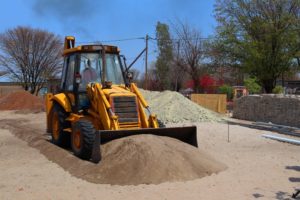
When it comes to filling holes, leveling out uneven terrain, and creating a compact foundation for buildings and roads, not all fill materials act the same way. Fill dirt and sand are two popular choices, but each one has its specific benefits and drawbacks. Grading and excavation contractors, asphalt paving experts, and other construction professionals must know how each material behaves and when to use it. Here are some of the key differences and uses for fill dirt and sand in construction.
All About Fill Dirt
The soil you have in your garden likely isn’t what a construction crew would use as fill material; garden soil is full of nutrients and organic matter, while fill dirt is gathered from the layer of earth beneath this fertile topsoil. Fill dirt is typically devoid of most organic matter, which can decompose over time and cause foundations to shift. This is why “clean” backfill is essential: the material must be free of vegetation, decomposing organic matter, pollutants, and debris in order to create a firm, stable foundation.
Sand Offers Better Drainage Than Fill Dirt, But Has Its Drawbacks
Sand comes in many varieties, each with unique grain size, grain shape, color, and consistency. Unlike soil, individual grains of sand do not absorb water or swell when damp. For the most part, sand is prone to displacement to a greater degree than fill dirt, which can be compacted very well. This displacement and tendency to shift and slip means that while sand is ideal for drainage purposes, there are some instances where its presence can be a liability.
Common Projects Using Fill Dirt
Projects that use fill dirt are all around you! The material is a popular choice when leveling out hills and holes in parks, front yards, and fields. Your home’s underground utilities are likely held in place with the substance, and it’s a common feature beneath roads and buildings.
When Sand is Superior
Soil is inexpensive and abundant, making it a popular choice for fill. However, there are some projects that require sand’s excellent drainage. Sand is common in constructed ponds or lakes, stormwater management systems, and low-lying areas that need drainage. Your septic tank and underground utilities may be held in place with sand, as well. Sand is often used for pipe bedding and to secure underground containers, structures, and plumbing.
ABOUT RELIABLE CONTRACTING
Reliable is dedicated to delivering quality products, displaying professionalism within the firm, seeking new opportunities for expansion and profitability, and providing an environment for individual success. If you have a commercial or residential construction project that you need taken care of, please contact Anne Arundel County’s largest site-work contractor today by calling 410-987-0313 or visiting our website. You can also follow Reliable Contracting on Facebook, LinkedIn, Pinterest, and Twitter!
Reliable Contracting Company serves the following and surrounding counties: Annapolis, Queen Anne’s, Anne Arundel, Baltimore, Baltimore City, Calvert, Caroline, Charles, Howard, Prince George, St. Mary’s, Talbot, and Washington D.C.
